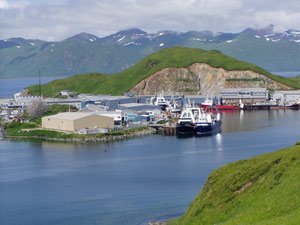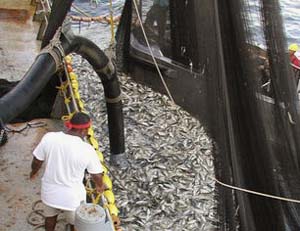
Dutch Harbor, the top port with the highest volume of catch this year.
High resolution (Credit: NOAA)
U.S seafood landings reached a 17-year high in 2011, thanks in part to rebuilding fish populations, and the value of landings also increased, according to a new report released today by NOAA.
According to the report, Fisheries of the U.S. 2011, U.S. commercial fishermen landed 10.1 billion pounds of fish and shellfish in 2011, valued at $5.3 billion, an increase over 2010 of 1.9 billion pounds and in excess of $784 million. Much of the increase is due to higher catches of Gulf menhaden, Alaska pollock, and Pacific hake, also known as whiting.
"Commercial and recreational fishing are integral to the nation's social and economic fabric," said Sam Rauch, deputy assistant N.O.A.A. administrator for NOAA's Fisheries Service. "To see landings and value climb again this year shows we're moving in the right direction and that the fishing industry is strengthening as fish populations rebuild. Our goal is to support a thriving, sustainable seafood industry that is competitive in the global marketplace, and to enjoy the benefits of recreational fishing in our own waters."
In excess of ten million recreational saltwater anglers in the U.S. took 69 million marine fishing trips in 2011 and caught 345 million fish, releasing nearly 60 percent of them alive. Spotted sea trout remained the top catch for recreational anglers, with 41 million caught in 2011. Atlantic croaker, sand sea trout, spot, and kingfishes were the other most common catches for saltwater anglers last year.
Today's report shows that the Alaska port of Dutch Harbor-Unalaska led the nation with the highest amount of fish landed - primarily pollock - for the 15th consecutive year. For the 12th consecutive year, New Bedford, Massachusetts had the highest valued catch, due mostly to the sea scallop fishery. However, scallops are a bright spot in New England fishery: despite fishermen staying within catch limits, several key groundfish stocks have declined unexpectedly, leading the Department of Business to declare a disaster for groundfish fishermen on Sept. 13. Similar announcements were made that day for chinook salmon in Alaska's Yukon and Kuskokwin rivers and Cook Inlet, and for the oyster and blue crab fisheries in Mississippi.
Catches throughout the Gulf of Mexico rebounded in 2011 to the highest volume since 1999, following a curtailed 2010 season due to the Deepwater Horizon oil spill. The full fishing season in 2011 produced commercial landings of Gulf menhaden that were 66 percent higher than 2010 landings, with Gulf fishermen bringing in In excess of 1.6 billion pounds of menhaden valued at $110 million. Gulf shrimp landings rose 20 percent, from 176 million pounds valued at $338 million in 2010 to 212 million pounds valued at $418 million in 2011.
The report also shows that the average American ate 15 pounds of fish and shellfish in 2011, less than the 2010 figure of 15.8 pounds. Altogether, Americans consumed 4.7 billion pounds of seafood, making the U.S. 2nd only to China in seafood consumption.

Gulf of Mexico menhaden. (Credit: NOAA)
In 2011, about 91 percent of seafood consumed in the U.S. was imported, up 5 percent from 2010. However, a portion of this imported seafood is caught by American fishermen, exported overseas for processing and then re-imported to the U.S. The top 3 imports are shrimp, canned tuna, and tilapia fillet.
Almost half of imported seafood comes from aquaculture, or farmed seafood. America's aquaculture industry currently meets less than 5 percent of U.S. seafood demand, producing primarily oysters, clams, mussels, and some finfish, including salmon.
"By promoting sustainable domestic aquaculture to complement rebuilt wild fisheries, we can create more jobs and provide additional local sources of seafood that meet the highest requirements for environmental protection and food safety," said Rauch.
NOAA's mission is to understand and predict changes in the Earth's environment, from the depths of the ocean to the surface of the sun, and to conserve and manage our coastal and marine resources. Visit us at www.noaa.gov and join us on Facebook, Twitter and our other social media channels.

